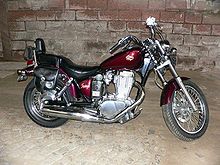Suzuki LS 650 Savage
The Suzuki LS 650 Savage is a motorcycle model from the Japanese manufacturer Suzuki , which was produced for the German market from 1986 to 2000. In other countries, a model that has only been slightly modified is still available today under the name Boulevard S40 . The Savage has a square-head , single-cylinder engine with four valves and a balance shaft . Its roots go back to the Suzuki DR600 . Power is transmitted to the 15-inch rear wheel using a toothed belt . Until 1994 the engine was only available with 27 hp in Germany. Then there was also the internationally common 31 HP version in Germany. The transmission initially had four gears, from 1991 it was delivered with five gears. A flat handlebar was also available until 1988.
The Suzuki LS650 Savage is designed as a chopper , so it is not suitable for high cornering speeds. The Savage is a very easy to rebuild motorcycle.
Weak points of the motorcycle
Timing chain tensioning system
The engine's weak point is the timing chain tensioning system, which should be checked at the latest after a mileage of around 20,000 km. The cause lies in the design of the chain tensioner. It mainly consists of a socket and a rack. As the (normal) elongation of the timing chain progresses, the toothed rack continues to extend in order to compensate for the elongation of the chain and to ensure the correct tension. The tensioner continues to extend until it falls apart and no longer holds the chain under tension. If the tensioner falls apart, engine damage is to be expected, the piston then hits the valves. As a precaution, the entire valve train is often replaced by workshops. Frequent low-speed driving promotes the elongation of the chain.
camshaft
The camshaft also tends to pitting , or the normal wear and tear on the cams of the shaft exposes casting cavities. Casting cavities are air pockets that arise when the part is cast. Due to the uneven surface, the wear increases sharply and leads to consequential damage to the valve train.
Starter pinion
Under certain circumstances, this damage can be identified by a hoarse, rubbing and hitting noise when starting. From the year of construction 1996 a slip clutch was installed on the starter. This is to prevent the starter from being damaged. However, the slip clutch can usually be retrofitted and costs around € 40.
Belt drive
Another point that deserves attention is the pulley / front wheel of the belt drive. Often its fastening nut loosens and the drive wheel of the belt moves on the shaft. This movement causes wear / abrasion of both the wheel and the shaft. The cover over the belt pulley can be removed for checking. The beginning of play at this point can be recognized by rust on the mounting surface of the belt pulley. If there are traces of rust on this surface, two things should be done: firstly, check the condition of the mounting surface of the wheel, replace it if necessary and / or tighten the nut again accordingly; second, check the condition of the mounting surface of the shaft that drives the wheel. If necessary, the shaft must be replaced. Because it is the transmission output shaft, this repair becomes expensive. Existing play or a belt pulley that has already been loosened can, under certain circumstances, be recognized by a pounding noise when accelerating. The cause will be as follows: The pulley is painted at the factory, the paint is peeling off and the first game is here. Due to the constant load changes when driving, the game then increases constantly. Excessive tightening torques do not necessarily help, rather removing the paint before installing the pulley. A front pulley costs around € 90, a new shaft around € 180, but its installation costs around € 700–800. It is recommended to check the fastening nut of the front pulley every 6000 km for tightness.
Swing arm bearing
It is also important to check the swing arm bearings (as with every used motorcycle purchase). With the LS650, the left bearing is particularly interesting. Over time, normal condensation forms in the frame tubes. However, since the motorcycle is always parked on the side stand due to the lack of a main stand, part of it collects in the left swing arm bearing and causes corrosion and wear there. The swing arm mounting is important for driving stability.
Technical specifications
- Year of construction: 1986-2000
- Engine: air-cooled, 4-stroke, single cylinder
- Displacement: 652 cm³
- Bore × stroke: 94 × 94 mm
- Output: 20 kW at 5,200 rpm
- Torque: 45.8 Nm at 3,000 rpm
- Valve control: 4 valves, OHC
- Carburetor: 1 Mikuni 40 mm
- Transmission: 4-speed; from 1991 5-speed
- Secondary drive: toothed belt
- Chassis: monotube frame
- Spring travel from / h .: 140/80 mm
- Wheelbase: 1,480 mm
- Brakes v./h .: disc / drum
- Tires v./h .: 100 / 90-19 / 140 / 80-15 or 140 / 90-15
- Seat height: approx. 700 mm
- Tank capacity: 11 l
- Oil filling quantity: 2.1 l (with oil filter change) The information in the operating instructions and in the booklet is incorrect!
- Oil consumption per 1,000 km: up to 1 l
- Weight: 171 kg
- Top speed: 145 km / h
Web links
Forum: http://www.ls650.eu/
